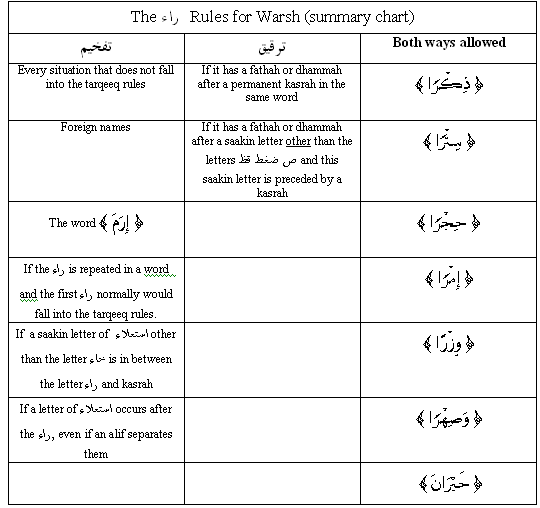12.  Tafkheem and tarqeeq of the letter
Tafkheem and tarqeeq of the letter 
A. Warsh reads with tarqeeq of the ![]() if it has a
if it has a ![]() or
or ![]() and preceded by a permanent kasrah or by a
and preceded by a permanent kasrah or by a ![]() saakinah in the same word, such as in:
saakinah in the same word, such as in: ![]() and
and ![]() and
and ![]() .
.
If the ![]() saakinahor kasrah that precedes the
saakinahor kasrah that precedes the ![]() are from a separate word, then there will not be tarqeeq of the
are from a separate word, then there will not be tarqeeq of the ![]() if it has a
if it has a ![]() or
or ![]() , as in:
, as in: ![]() and
and ![]() . You may notice that the letter
. You may notice that the letter ![]() in the last example is written in with the word, but it is a
in the last example is written in with the word, but it is a ![]() , or preposition in this case, and a separate word. If there is a
, or preposition in this case, and a separate word. If there is a ![]() voweled by other than a kasrah before the
voweled by other than a kasrah before the ![]() that has an accompanying dhammah or fat-hah there is no tarqeeq of the
that has an accompanying dhammah or fat-hah there is no tarqeeq of the ![]() , such as in:
, such as in: ![]() .
.
B. A saakin letter between the ![]() and the kasrah does not stop the
and the kasrah does not stop the ![]() from having tarqeeq, such as in:
from having tarqeeq, such as in: ![]() and
and ![]() , but an exception is made if the saakin letter is one of the letters of
, but an exception is made if the saakin letter is one of the letters of ![]() other than
other than ![]() ; in this case, the
; in this case, the ![]() would have tafkheem. Examples of this last rule of tafkheem are:
would have tafkheem. Examples of this last rule of tafkheem are: ![]()
![]()
![]() .
.
C. The ![]() has tafkheem if it has any of the previous circumstances for tarqeeq in the recitation of Warsh in a foreign word (
has tafkheem if it has any of the previous circumstances for tarqeeq in the recitation of Warsh in a foreign word ( ![]() ), such as
), such as ![]() ,
, ![]() , and
, and ![]() .
.
D. There is also tafkheem of the ![]() in the recitation of Warsh if it is preceded by a kasrah, or preceded by a saakin occurring after a kasrah, but the
in the recitation of Warsh if it is preceded by a kasrah, or preceded by a saakin occurring after a kasrah, but the ![]() is repeated with an alif in between the two
is repeated with an alif in between the two ![]() . Examples are:
. Examples are: ![]()
![]()
![]()
E. Warsh reads the word ![]() of aayah 7 from surah Al-Fajr with tafkheem on the
of aayah 7 from surah Al-Fajr with tafkheem on the ![]() .
.
F. There is tarqeeq of both ![]() when stopping and continuing in the word:
when stopping and continuing in the word: ![]() in aayah 32 of surah Al-Mursalaat, in the recitation of Warsh.
in aayah 32 of surah Al-Mursalaat, in the recitation of Warsh.
G. If the ![]() or the alif before a
or the alif before a ![]() saakinah is read with imaalah, there is tarqeeq of the
saakinah is read with imaalah, there is tarqeeq of the ![]()
H. Both tafkheem and tarqeeq of the ![]() are allowed in the following words:
are allowed in the following words:
2:200 ![]() , and 18:70, 83, 20:99 and 113, 21:48, 33:41, 37:3, and 168, 65:10, 77:5
, and 18:70, 83, 20:99 and 113, 21:48, 33:41, 37:3, and 168, 65:10, 77:5
![]() Al-Kahf (18:90)
Al-Kahf (18:90)
![]() Al-Furqan (25:22, 53)
Al-Furqan (25:22, 53)
![]() Al-Kahf (18:71)
Al-Kahf (18:71)
![]() TaHa (20:100)
TaHa (20:100)
![]() Al-Furqan (25:45)
Al-Furqan (25:45)
These six above words only have tafkheem of the ![]() when being read with
when being read with ![]() (four vowel counts on
(four vowel counts on ![]() ) the other two vowel counts for
) the other two vowel counts for ![]() (two vowel counts and six vowel counts) have the same general rule as stated at the beginning, that of tarqeeq and tafkheem being allowed .
(two vowel counts and six vowel counts) have the same general rule as stated at the beginning, that of tarqeeq and tafkheem being allowed .
There is also both tafkheem and tarqeeq allowed on the word, ![]() Al-An’Aam (6:71) with no restrictions as to
Al-An’Aam (6:71) with no restrictions as to ![]() .
.
H. Warsh has tafkheem of the ![]() if it is followed directly by a letter of
if it is followed directly by a letter of ![]() , or indirectly (meaning an alif is in between) by a letter of
, or indirectly (meaning an alif is in between) by a letter of ![]() , even if it meets the conditions of tarqeeq. Examples are:
, even if it meets the conditions of tarqeeq. Examples are: ![]()
![]()
![]() .
.
The word ![]() in surah Ash-Shu'araa', aayah 63 though can be read with either tafkheem or tarqeeq of the
in surah Ash-Shu'araa', aayah 63 though can be read with either tafkheem or tarqeeq of the ![]() .
.
The following chart summarizes the rules of ![]() for the recitation of Warsh:
for the recitation of Warsh:

